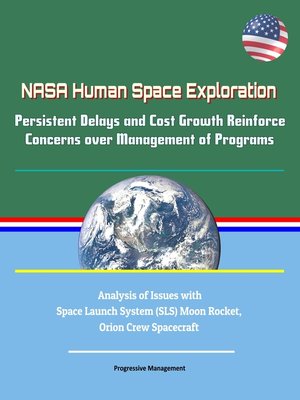NASA Human Space Exploration
ebook ∣ Persistent Delays and Cost Growth Reinforce Concerns over Management of Programs--Analysis of Issues with Space Launch System (SLS) Moon Rocket, Orion Crew Spacecraft

Sign up to save your library
With an OverDrive account, you can save your favorite libraries for at-a-glance information about availability. Find out more about OverDrive accounts.
Find this title in Libby, the library reading app by OverDrive.



Search for a digital library with this title
Title found at these libraries:
| Library Name | Distance |
|---|---|
| Loading... |
This report from the GAO, issued in June 2019, has been professionally converted for accurate flowing-text e-book format reproduction. NASA is undertaking a trio of closely related programs to continue human space exploration beyond low-Earth orbit. All three programs (SLS, Orion, and supporting ground systems) are working toward a launch readiness date of June 2020 for the first mission. Due to continued production and testing challenges, the National Aeronautics and Space Administration's (NASA) three related human spaceflight programs have encountered additional launch delays and cost growth. In November 2018, within one year of announcing an up to 19-month delay for the three programs— the Space Launch System (SLS) vehicle, the Orion spacecraft, and supporting ground systems—NASA senior leaders acknowledged the revised date of June 2020 is unlikely. Any issues uncovered during planned integration and testing may push the launch date as late as June 2021. Moreover, while NASA acknowledges about $1 billion in cost growth for the SLS program, it is understated. This is because NASA shifted some planned SLS scope to future missions but did not reduce the program's cost baseline accordingly. When GAO reduced the baseline to account for the reduced scope, the cost growth is about $1.8 billion.
In addition, NASA's updated cost estimate for the Orion program reflects 5.6 percent cost growth. The estimate is not complete, however, as it assumes a launch date that is 7 months earlier than Orion's baseline launch date. If the program does not meet the earlier launch date, costs will increase further. Updating baselines to reflect current mission scope and providing complete cost estimates would provide NASA management and Congress with a more transparent assessment of where NASA is having difficulty controlling costs. NASA paid over $200 million in award fees from 2014-2018 related to contractor performance on the SLS stages and Orion spacecraft contracts. But the programs continue to fall behind schedule and overrun costs. Ongoing contract renegotiations with Boeing for the SLS and Lockheed Martin for the Orion program provide NASA an opportunity to reevaluate its strategy to incentivize contractors to obtain better outcomes.
This compilation includes a reproduction of the 2019 Worldwide Threat Assessment of the U.S. Intelligence Community.







